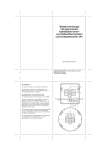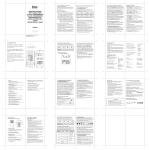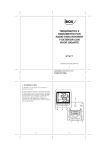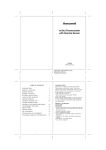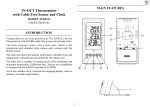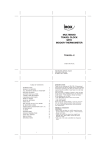Download Cresta WX171 weather station
Transcript
English IN-OUT THERMOMETER WITH CABLE FREE SENSOR AND RADIO CONTROLLED CLOCK INTRODUCTION: Congratulations with the purchase if the In/Out Thermometer with wireless sensor and radio controlled clock. The basic package comes with a main unit (the temperature / clock station) and a remote unit (the thermo sensor). The main unit has large displays for time/date, indoors temperature and outdoors temperature as received from the remote unit. The main unit can receive data from up to 3 remote units. The main unit has a memory for maximum and minimum reached temperatures of different sites. The remote units have a range up to 30 meters, this range can be influenced by several factors (concrete walls, electric wires, other sending devices, etc.) The sensors are weatherproof and can be used outdoors, but should not be submerged into water or hung in a place where rain can reach the unit. The clock/calendar function is radio controlled. The day can be displayed in 5 languages and the unit has a 2 minute crescendo weekly and daily alarm. The clock is synchronised with the atom clock in Frankfurt Germany, this clock has a range of 1.500 km and your clock will receive the time signal 12 to 24 times a day and will correct, if necessary. When you first operate your clock, it can take up to 60 minutes before the radio signal is received and the correct time is set. USER'S MANUAL ( TE217/TE217EL) 17 18 NILBRAND TE217/TE217EL & TS02C MANUAL (ENG) SIZE: W65 X H105 (mm) BY SHAN WONG 28/11/05 When you put the main unit and the remote unit next toe ach other, you will notice a minimal difference in temperature. This is caused by the software used and the insulation of the outdoors sensor, this sensor is calibrated on the average outdoors temperature, whereas the main unit is calibrated on the average indoors temperature. This is no defect in the units A FOUR-LINE DISPLAY Facilitates easy reading of remote and indoors temperatures and calendar clock At temperatures below freezing point the operation can be distorted, this is caused because the batteries cannot deliver the power needed to operate the unit correctly. You can avoid this by using branded batteries and change them just before the winter starts. C MEMORY [MEM] BUTTON Recalls the maximum or minimum temperature of main and remote unit F G TREND A MIN MAX D MODE BUTTON Toggles the display modes and confirms entry while setting the values for display E ALARM BUTTON Displays the alarm time or sets the alarm status F SNOOZE BUTTON or SNOOZE/LIGHT BUTTON Activate the snooze function RADIO CONTROLLED CH B CHANNEL BUTTON Display different sensor temperature TREND G WALL-MOUNT RECESSED HOLE For mounting the main unit on a wall IN AM ZONE PM PRE-AL AM PM M D D M min 4 3 3 M H z H UP ( ) BUTTON Advances the value of a setting w s W I R E L E S S CHANNEL MEM I DOWN ( ) BUTTON Decreases the value of a setting H J BATTERY COMPARTMENTS Accommodates two UM-3 or “AA” size 1.5V alkaline batteries ALARM ON / OFF MODE D B C I E J K REMOVABLE TABLE STAND For standing the main unit on a flat surface K 19 20 MAIN FEATURES: REMOTE UNIT E WIRELESS THERMOMETER A C D F CHANNEL 1 2 3 SIZE AA / UM3 SIZE AA / UM3 B RESET A LED INDICATOR Flashes once when the remote unit transmits a reading Flashes twice when low battery is detected on sensor unit B BATTERY COMPARTMENT Accommodates two AA-size batteries C RESET BUTTON Press to reset all setting if you have selected different channel. D CHANNEL SELECTOR Select the channel before you install batteries. BEFORE YOU BEGIN For best operation, 1. Insert batteries for remote units before doing so for the main unit. 2. Place the main unit as close as possible next to the remote unit. 3. Position the remote unit and main unit within effective transmission range, which, in usual circumstances, is 20 to 30 meters. Note that the effective range is vastly affected by the building materials and where the main and remote units are positioned. Try various set-ups for best result. Though the remote units are weather proof, they should be placed away from direct sunlight, rain or snow. BATTERY INSTALLATION: REMOTE UNIT 1. Remove the screws on the battery compartment. 2. Select the channel 3. Install 2 batteries (UM-3 or “AA” size 1.5V) strictly according to the polarities shown. 4. Replace the battery compartment door and secure its screws. BATTERY INSTALLATION: MAIN UNIT 1. Open the battery compartment door. 2. Install 2 batteries (UM-3 or “AA” size 1.5V) strictly according to the polarities shown. 3. Replace the battery compartment door. E WALL-MOUNT RECESSED HOLE Supports the remote until in wall-mounting F ˚C / ˚F BUTTON 21 22 LOW BATTERY WARNING When it is time to replace batteries, the respective low-battery indicator will show up on the indoor or outdoor temperature. Repeat this step whenever you find discrepancies between the reading shown on the main unit and that on the remote unit. HOW TO USE THE TABLE STAND OR WALL MOUNTING The main unit has a removable table stand, which when connected, can support the unit on a flat surface. Or you can remove the stand and mount the unit on a wall using the recessed screw hole. As for the remote unit, you can place it on a flat surface or mount the unit on a wall using the recessed screw hole. HOW TO CHECK REMOTE AND INDOOR TEMPERATURES The indoors temperature is shown on the second line of the display. The outdoors temperature is shown on the top line of the display. The wave display on the outdoors temperature indicates the reception of the remote unit is in good order. If no readings are received from the remote unit for more than two minutes, blanks “ ” will be displayed until further readings are successfully searched. Check the remote unit is sound and secure. You can wait for a little while or Hold [ ] for 2 seconds to enforce an immediate search. If the temperature goes above or below than the temperature measuring range of the main unit or the remote unit (stated in specification), the display will show “ ” GETTING STARTED Once batteries are in place for the remote unit, they will start transmitting temperature readings at around 45 seconds intervals. The main unit will also start searching for signals for about two minutes once batteries are installed. Upon successful reception, the outdoors temperatures will be displayed on the top line and the indoors temperature on the bottom line. The main unit will automatically update its readings at about 45-second intervals. If no signals are received, blanks “ ” will be displayed. Hold [ ] for 2 seconds to enforce another search for about 2 minutes. This is useful in synchronizing the transmission and reception of the remote and main units. HOW TO READ THE KINETIC WAVE DISPLAY The kinetic wave display shows the signal receiving status of the main unit. There are three possible forms: The unit is in searching mode. Temperature readings are securely registered. ˚C No signals. 23 24 MAXIMUM AND MINIMUM TEMPERATURES The maximum and minimum recorded indoor and outdoor temperatures will be automatically stored in memory. To display them, Press [ MEM ] once to display the maximum temperature and again the minimum temperature. The respective indicators, [ MAX ] or [ MIN ] will be displayed. To clear the memory, hold down [ MEM ] for two seconds. The maximum and minimum temperatures will be erased. If you press [ MEM ] now, the maximum and minimum temperatures will have the same values as the current ones until different readings are recorded. DISCONNECTED SIGNALS If without obvious reasons the display of the outdoor temperature goes blank, Hold [ ] for 2 seconds to enforce an immediate search. If that fails, check: 1. The remote unit is still in place. 2. The batteries of both the remote unit and main unit. Replace as necessary. Note: When the temperature falls below freezing point, the batteries of outdoor units will freeze, lowering their voltage supply and the effective range. 3. The transmission is within range and path is clear of obstacles and interference. Shorten the distance when necessary. TRANSMISSION COLLISION Signals from other household devices, such as door bells, home security systems and entry controls, may interfere with those of this product and cause temporarily reception failure. This is normal and does not affect the general performance of the product. The transmission and reception of temperature readings will resume once the interference recedes. Different channel may be reduce the interference. 25 HOW TO SET AND ARM THE ALARM To set an alarm, 1. Press [ALARM] once to display alarm time. If the alarm is disarmed, the time will be displayed as “ OFF ”. 2. Hold [ALARM] for two seconds. The hour digits will blink. 3. Enter the hour using [ ] or [ ]. 4. Press [ALARM]. The minute digits will blink. 5. Enter the minutes using [ ] or [ ]. 6. Press [ALARM] to exit. 7. Repeat the same procedure to set single alarm. The alarm “ W” “ S ” and “ Pre-AL” icons will be displayed indicating which alarm is armed. You can also arm or disarm an alarm by pressing the [Up], [Down] button at alarm display mode. Press MODE to return to clock display mode. SNOOZE FEATURE When the alarm sound is on, press the snooze key enter snooze mode. After 8 minutes, it alarm sound will be wake up automatically. The snooze cycle will be restart if you press the snooze key again. If you leave the alarm sound on for 2 minutes, it will enter snooze mode automatically with maximum 3 times. HOW TO STOP AN ALARM Press [ALARM] on the unit to stop an alarm. 27 HOW TO SET THE RADIO CONTROLLED CLOCK *After the batteries are installed. The clock will automatically search the radio signal. It takes about 3-5 minutes to finish this process. *If the radio signal is received, the date & time will be set automatically with radio control signal icon [ ] turns on. *If the clock fails to receive the time signal, it will be with the [ ] icon turns off. Then user can set the time manually. *Radio-controlled signal will be scheduled to receive every hour. - Receiving - Strong - No singal No symbol -signal recepttion disabled CALENDAR CLOCK DISPLAY MODES The clock and the calendar share the same section of the display. The calendar is displayed in a day-month format. Each press on the MODE button will change the display between clock with second, clock with day of week, zone time with second and day-month. HOW TO SET THE CLOCK MANUALLY To set the clock manually, hold MODE for two seconds it will show the year. Use [ ] or [ ] to change it. Press MODE to confirm. Repeat the same procedure to set the month, date, date-month format, 12/24, hour, minute, display language, zone time offset and ˚C/˚F. During the setting, press and hold [ ] or [ ] will increase or decrease the value rapidly. For display language, you can choose among English-En, German-DE, French-Fr, Italian-IT and Spanish-SP. - in that order. If there is an item you do not wish to change, simply press [ MODE ] to bypass the item. When you finished the change, press [ MODE ] to exit. The display will return to the clock mode. 26 PRECAUTIONS This product is engineered to give you years of satisfactory service if you handle it carefully. Here are a few precautions: 1. Do not immerse the unit in water. 2. Do not clean the unit with abrasive or corrosive materials. They may scratch the plastic parts and corrode the electronic circuit. 3. Do not subject the unit to excessive force, shock, dust, temperature or humidity, which may result in malfunction, shorter electronic life span, damaged battery and distorted parts. 4. Do not tamper with the unit's internal components. Doing so will invalidate the warranty on the unit and may cause unnecessary damage. The unit contains no user-serviceable parts. 5. Only use fresh batteries as specified in the user's manual. Do not mix new and old batteries as the old ones may leak. 6. Always read the user's manual thoroughly before operating the unit. ALARM FEATURE * Weekday Alarm The alarm sound will be activated and the icon will be flashed on weekday when it is armed and the alarm time is reach. * Single Alarm The alarm sound will be activated and the icon will be flashed once when it is armed and the alarm time is reach. Once it finished, it will be disabled automatically. * Pre-Alarm The pre-alarm sound will be activated and the icon will be flashed if outdoor temperature under or equal zero degree. Which is programmable 15, 30, 45, 60 or 90 minutes earlier than the weekday alarm or single alarm time. 28 SPECIFICATIONS Temperature Measurement - Main unit Indoor Temperature measurement Proposed operating range Temperature resolution - Remote unit Proposed operating range Power Main unit : use 2 pcs UM-3 or ”AA” 1.5V battery Remote sensing unit : use 2 pcs UM-3 or “AA” 1.5V battery : -10.0°C to +50.0°C (14.0°F to 122.0°F) : 0.1°C (0.2°F) : -20.0°C to +60.0°C (-4.0°F to +140.0°F) : 0.1°C (0.2°F) : 433 MHz :3 : Maximum 30 meters (open area) : around 43~47 seconds Temperature resolution RF Transmission Frequency No. of Remote unit RF Transmission Range Temperature sensing cycle Calendar Clock 12/24 h display with hh : mm Date Format : Day - Month or Month-Day. Day of week selectable in 5 language (E, F, D, I,S) Dual 2-minute crescendo alarm with snooze Pre-alarm for ice warning 29 Weight Main unit : 170g (without battery) Remote sensing unit : 60g (without battery) Dimension Main unit : 81(L) x 165(H) x 47(D) mm Remote sensing unit : 55.5(L) x 101(H) x 24(D) mm CAUTION - The content of this manual is subject to change without further notice. - Due to printing limitation, the displays shown in this manual may differ from the actual display. - The contents of this manual may not be reproduced without the permission of the manufacturer. 30 EC-DECLARATION OF CONFORMITY Product : TE217/TE217EL This product contains the approved transmitter and complies with the essential requirements of Article 3 of the R&TTE 1999/5/EC Directives, if used for its intended use and that the following standard(s) has/have been applied: Efficient use of radio frequency spectrum (Article 3.2 of the R&TTE Directive) applied standard(s) EN 300 220-1,3:2000 Electromagnetic compatibility (Article 3.1.b of the R&TTE Directive) applied standard(s) EN 301 489-1,3:2000 applied standard(s) EN 300 339:2000 Additional information: The product is therefore conform with the Low Voltage Directive 73/23/EC, the EMC Directive 89/336/EC and R&TTE Directive 1999/5/EC (appendix II) and carries the respective CE marking. RTTE Compliant Countries : All EU countries, Switzerland CH And Norway N 0125 QA MANAGER : H.Y.WANG K.S plastic factory Guan Lan / Shen Zhen / China 31 32




